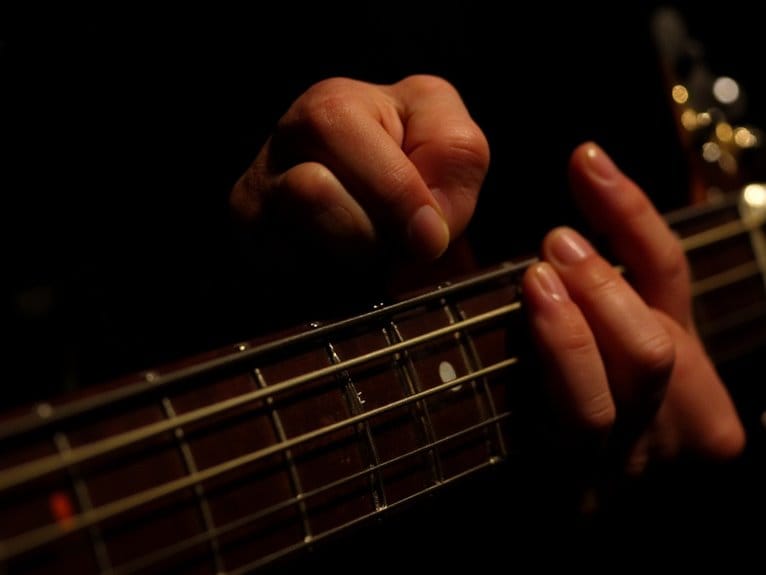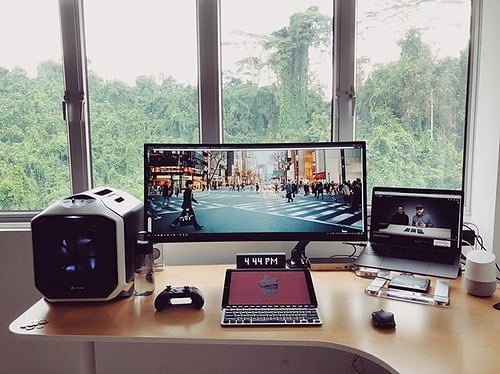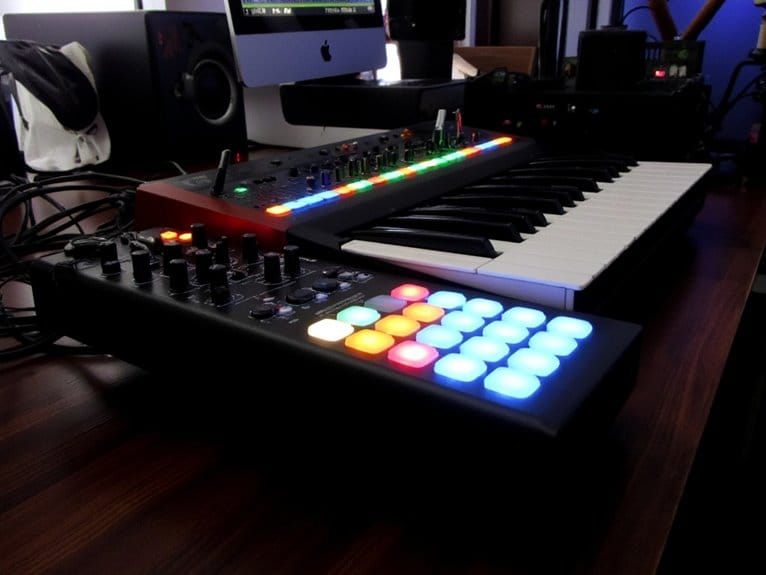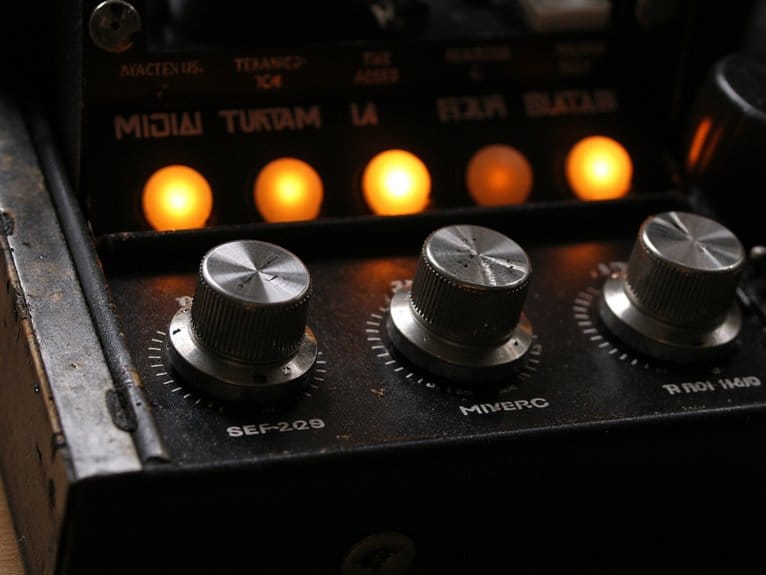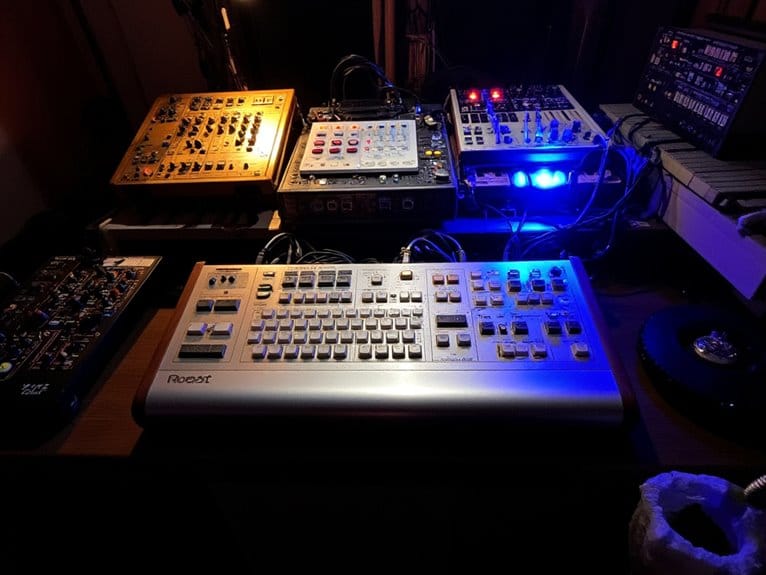Slap and Pop Techniques: Beyond the Basics
Beyond basic thumb-and-pop patterns, you’ll need to master syncopated rhythms across different time signatures, incorporating ghost notes and muted slaps that emphasize percussion over melody. Your tone depends on the entire signal chain-proper string action around 3/32″, strategic pickup placement, and subtle mid reduction for live clarity. Coordinate your fretting hand’s harmonic content with percussive muting while using alternating fingers for complex polyrhythmic grooves that span jazz, gospel, and fusion styles, and there’s much more sophisticated territory ahead.
We are supported by our audience. When you purchase through links on our site, we may earn an affiliate commission, at no extra cost for you. Learn more.
Notable Insights
- Combine thumb slaps with finger pops in syncopated patterns across 3/4 and 4/4 time signatures for complex rhythmic textures.
- Integrate ghost notes and muted slaps to emphasize percussive elements while maintaining groove momentum and harmonic sophistication.
- Use proper string action around 3/32″ with strategic pickup placement and subtle mid reduction for professional tone clarity.
- Layer hammer-ons, pull-offs, and fretting hand muting techniques to create intricate multi-dimensional bass lines without disrupting rhythm.
- Practice polyrhythmic coordination with backing tracks, alternating index and middle fingers for advanced genre fusion applications.
Advanced Rhythmic Variations and Cross-Genre Applications
Anyone who’s spent time mastering basic slap and pop techniques knows there’s a whole world beyond the standard thumb-slap, index-finger-pop routine, and that’s where advanced rhythmic variations really start to shine across different musical genres.
You’ll discover that combining simultaneous thumb and finger pops creates complex percussive textures, while incorporating 3/4 time signatures and syncopated rhythms adds groove complexity that transcends typical 4/4 patterns.
Ghost notes and muted slaps enhance your rhythmic foundation, emphasizing percussion over melody.
Genre fusion opens incredible possibilities-jazz players use slap techniques to mimic drum elements, gospel and fusion incorporate dynamic percussive accents, while rock and country benefit from accentuated rhythmic drive that traditional fingerstyle simply can’t deliver.
Tone Shaping and Sound Control for Professional Results
The difference between amateur and professional slap bass tone isn’t just about technique-it’s about understanding how every element in your signal chain, from string height to compression settings, works together to create that punchy, articulate sound that cuts through any mix.
Professional slap bass tone comes from understanding how your entire signal chain works together, not just perfecting your slapping technique.
Start with proper string action around 3/32″ on the bass side, which facilitates that essential string bounce while maintaining clean articulation. Your pickup placement and tone control adjustments shape frequency emphasis, so experiment with these before reaching for external EQ adjustments.
I’ve found that subtle mid reduction often improves clarity more than aggressive “smiley face” curves, which can kill note definition in live settings.
Compression settings require finesse-you want to even out dynamics between slap and fingerstyle without crushing expression. Just as drummers benefit from dual-zone capabilities in their trigger systems for enhanced versatility, bass players need compression that responds appropriately to different playing techniques.
Recording techniques demand different approaches than live performance, so adjust your signal chain accordingly for professional results. A quality bass preamp pedal with comprehensive 3-band EQ controls allows for precise tonal shaping that enhances slap technique clarity while maintaining the natural attack and sustain characteristics essential for professional recordings.
Building Complex Grooves Through Coordinated Hand Techniques
Three distinct layers work together when you’re building complex slap bass grooves: your thumb creates the foundational pulse like a kick drum, your popping fingers articulate the backbeat and melodic accents, and your fretting hand adds the harmonic content and percussive muting that transforms simple patterns into sophisticated rhythmic frameworks.
Your syncopation strategies develop through alternating index and middle fingers for pops while your thumb maintains steady quarter-note patterns, creating polyrhythmic tension that drives funk and fusion grooves forward.
Dynamic layering emerges when you incorporate hammer-ons and pull-offs between slap attacks, allowing melodic phrases to weave through percussive elements without disrupting the groove’s momentum.
I’ve found that practicing with backing tracks helps internalize these coordination patterns, making the shift from basic thump-pop exercises to intricate, multi-layered bass lines feel natural.
On a final note
You’ve now mastered the advanced slap and pop techniques that’ll separate you from weekend warriors, though I’ll admit perfecting these cross-genre applications takes more practice than I initially anticipated. Your tone control and coordinated hand movements should feel natural after working through these complex grooves, and honestly, you’ll probably surprise yourself with how quickly muscle memory develops. Keep experimenting with these rhythmic variations, because that’s where you’ll find your unique voice in this expressive technique.

